New Drone-Based System Assesses Highway-Rail Crossings to Improve Safety
The Challenge
Highway-rail incidents contribute to hundreds of fatalities a year, according to Federal Railroad Administration (FRA) data. The causes of these incidents vary, but in some cases a contributing factor is poor geometric design of the crossing.
One of the most common and dangerous situations can happen at what’s called a “humped crossing.” At this type of crossing, the tracks are at a significantly higher elevation than the roadway that approaches them, resulting in a high profile or a “hump,” causing some low-ground-clearance vehicles—such as buses, trucks, and trailers—to become stuck or lodged on the rails.
In one such incident in 2017, a motorcoach in Biloxi, Mississippi, became lodged on a high-profile highway-railroad grade crossing and was struck by a freight train, resulting in four deaths and 38 injuries.
The U.S. Department of Transportation (U.S. DOT) Small Business Innovation Research (SBIR) program worked to address the challenge of humped crossings through its annual Phase I solicitation.
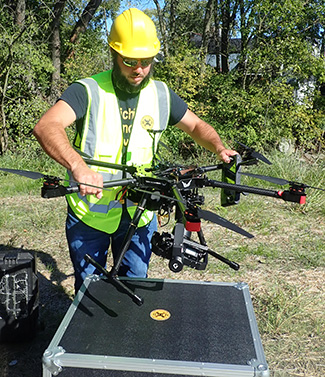
In 2020, FRA sponsored an SBIR project that would create an automated, drone-enabled highway-rail grade crossing inspection system to identify and assess the safety of crossings. Michigan Tech Research Institute (MTRI Inc.), a company based in Ann Arbor, Michigan, partnered with Michigan Technological University and was awarded SBIR funding to develop and demonstrate the Crossing-i system.
(FRA selected an additional small business, VisioStack, to develop a different solution to this SBIR topic. Read about VisioStack’s Aerial Crossing Inspection System.)
Small Business: MTRI Inc.
Location: Ann Arbor, Michigan
Project: Crossing-i
Funding Agency: Federal Railroad Administration
Phase I: $147,186
Phase II: $282,897
The Technology
Using high-resolution images collected via uncrewed aerial system (UAS), or “drone,” the Crossing-i system can determine whether vertical approach grades at railroad crossings create a risk for vehicles to get stuck on tracks. Using vehicle and train speeds, Crossing-i can also assess whether a crossing has acceptable visual sight lines based on requirements defined in the AASHTO Green Book, and locate relevant assets such as gates, lights, and signage.
The drone-collected images are processed into three-dimensional (3D) data for analysis. Users can view their results through a user-friendly web portal. The system’s 3D models can be used to automatically assess rail grade crossings for potential hang-up conditions and obstructed views of the intersection that contribute to highway-rail incidents.
This technology can identify and assess areas of rail crossing design that need improvement, leading to engineering solutions that enhance safety for the traveling public. The 3D results and drone video are also useful for producing diagnostic surveys, creating a virtual review environment that reduces the need for travel.
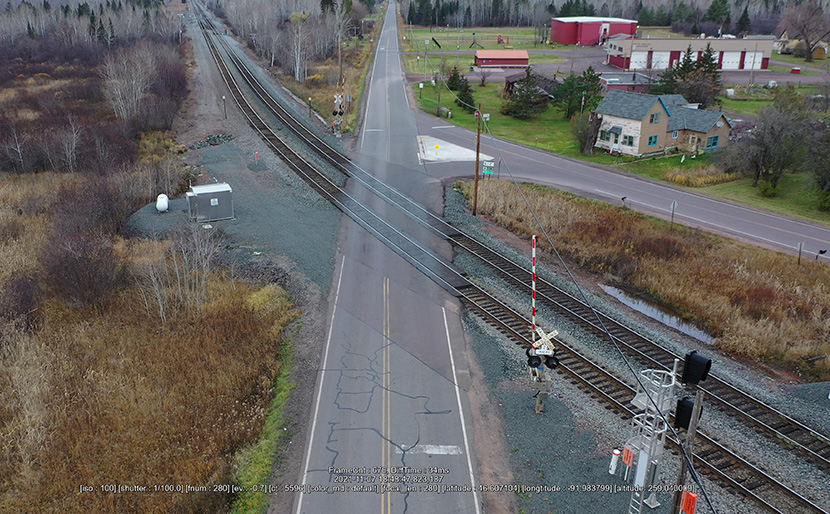
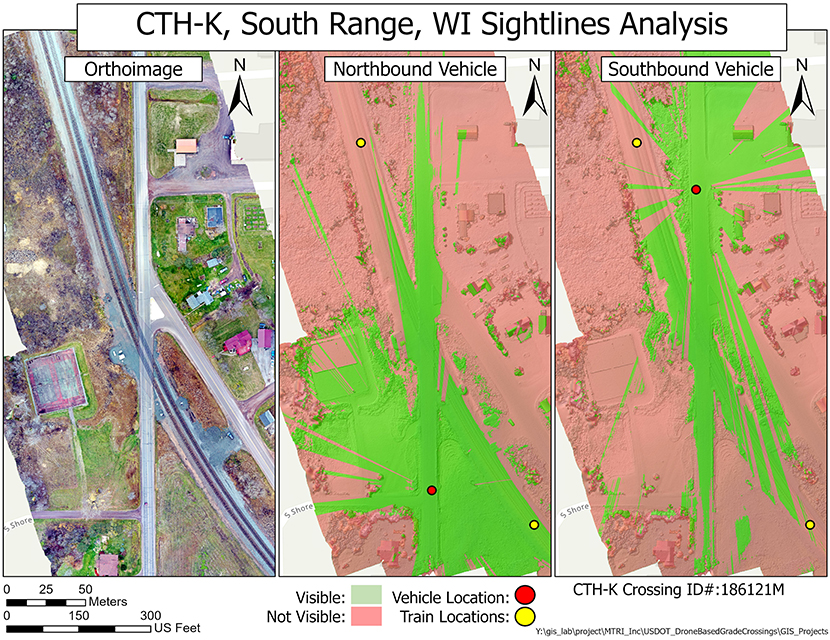
The Future
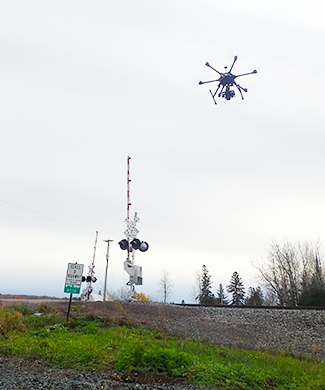
In collaboration with state rail agencies and rail companies, MTRI Inc. demonstrated its Crossing-i technology at highway-rail crossings in Illinois, Indiana, Michigan, Minnesota, and Wisconsin. The technology has been tested with new drones and is ready for deployment.
MTRI Inc.’s next steps are focused on partnering with agencies and organizations that are interested in providing Crossing-i services across the United States. The Crossing-i team has met with drone service providers, engineering firms, rail companies, and transportation agencies about using this technology as part of their day-to-day operations. Discussions are ongoing about providing commercial operation of Crossing-i in 2022 and beyond.
The Impact
There are approximately 212,000 highway-rail grade crossings in the United States. The Crossing-i technology helps identify those that pose a risk to highway users so that operators and agencies responsible for crossings can address those safety deficiencies.
The goal of Crossing-i is to help users such as state rail agencies, rail companies, commerce commissions, and FRA improve grade crossing safety through an easily deployable, rapid system that takes advantage of cost-effective 3D drone sensing.
This technology will help companies and agencies responsible for managing crossings to save money and to target safety improvements at specific rail crossings where problems exist. This system will also automatically identify needed signage, which will help ensure compliance with currently required grade crossing inspections.
The Crossing-i system will make it easier and less expensive to identify areas to improve technical insufficiencies at grade crossings, reducing the risk of highway-rail incidents.
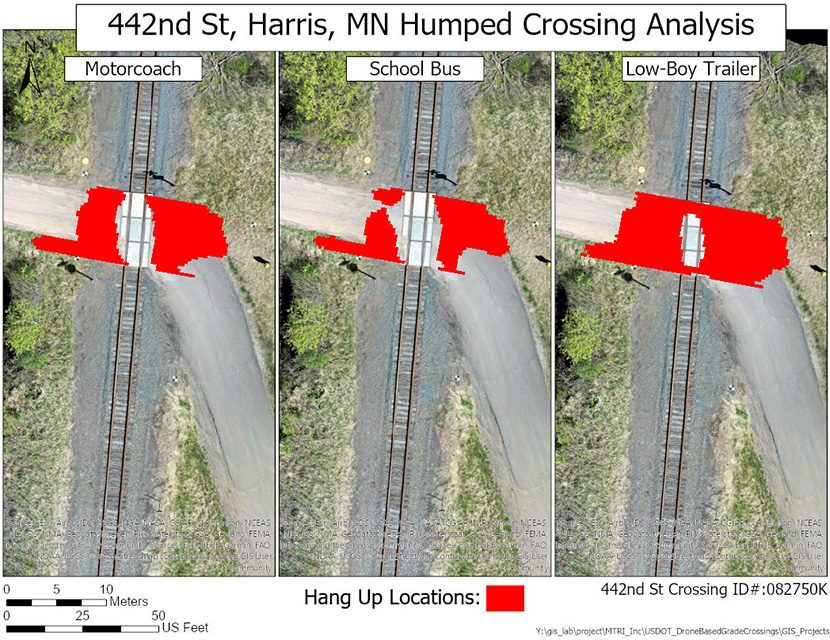
How SBIR Helps
The Phase I and Phase II SBIR awards have made it possible for MTRI Inc. to advance the capabilities of automated drone-enabled assessment of grade crossing infrastructure.
“The SBIR funding has enabled the Crossing-i technology to be taken to the point of readiness for practical deployment of drones for finding grade crossing safety issues,” said Greg Leonard, president of MTRI Inc.
About SBIR
The U.S. Department of Transportation’s highly competitive Small Business Innovation Research (SBIR) program awards contracts to domestic small businesses to pursue research on and develop innovative solutions to transportation challenges.
Moreover, the SBIR program encourages small businesses to engage in federal research/research and development (R/R&D) that has the potential for commercialization. The program awards contracts in two phases, and it recognizes a third phase leading up to commercialization. See Past Solicitations and Awardees for more information.
